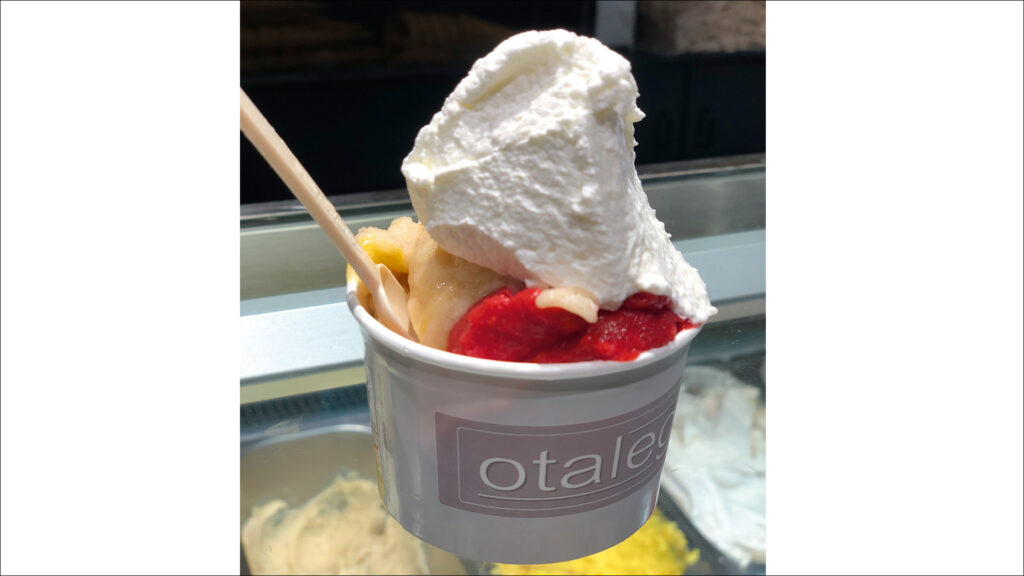A holiday in this city of romance and beauty is incomplete without copious amounts of delicious gelato.
By PRACHI JOSHI

Dressed in a white shirt and blue skirt, a pretty, runaway princess
sits on the Spanish Steps in Rome, enjoying a gelato. A tall American journalist offers to show her around the city. She tosses away the cone, and so begins a day of romance and adventure. There’s something ethereally special about this scene from the Audrey Hepburn and Gregory Peck-starrer, Roman Holiday. I remember watching it as a child, and on our first trip to the Italian capital nearly
a decade ago, my husband and I made a beeline to the same spot, gelatos in hand—pistachio (that quintessentially Italian flavour) for me and a mouth-puckering limone (lemon) for him. It was love at first bite. That, however, is not this delectable delight’s sole claim to cinematic fame. Elizabeth Gilbert’s journey in Eat Pray Love features Julia Roberts savouring one on a bench in Piazza Navona. The scene sparked a frenzy as tourists thronged the Il Gelato di San Crispino gelateria to sample what Gilbert declared, “The best gelato in Rome!” But is there such a thing? Ask five Romans and they will likely reel off five different places as their favourite. Over multiple trips, I, too, found several worthy contenders.
The Real Deal
Believe it or not, Rome (and the rest of Italy) has plenty of unremarkable gelato to offer if you don’t know what to look out for. On my first trip, I took a food tour with Eating Europe in the historic Testaccio neighbourhood, considered to be the birthplace of cucina Romana (Roman cuisine). Amidst samplings of cheese, cured meats, and pasta, my guide ushered our group into Giolitti, a branch of one
of the oldest gelaterias in Rome. There, the owner Armando told us how to check if your gelato is the real deal. “First, the gelato colour should not be too fluoro or bright. Pistachio should be dull brownish green; if it’s bright green, there’s artificial colour in it. Lemon should be white and not yellow, and strawberry shouldn’t be neon pink,” he said. Another indicator of mediocre gelato is if it’s too airy and piled high above the rim of the container. “This means artificial stabilisers have been added,” said Armando. An artigianale (artisanal) gelateria uses fresh, seasonal ingredients; fruit flavours are a good indicator. So, berries and stone fruits are great in June but not in January.
Gelato-Hopping

One can often feel warm and tired while sightseeing in Rome. And so, it’s best to punctuate it with frequent gelato breaks. Fortunately, many good gelaterias have prime locations near Rome’s most-visited attractions. Across from the Pantheon on Via del Pantheon is the very popular Gelateria Fiocco di Neve, offering a wide range of tempting, gluten-free flavours. Try the riso del moro (chocolate with rice crispies) or ricotta with pistachio here. Lip-smacking good!

It’s only a short walk from the Pantheon to the Trevi Fountain, but if you feel like another gelato, head to Gilbert’s favourite Il Gelato di San Crispino, and order a delicious, traditional crema topped with the al miele (honey) flavour. Or try the slightly potent crema all’armagnac, laced with barrel-aged brandy. Near Piazza Navona is Gelateria del Teatro, which does some innovative fruit and herb concoctions like sage and raspberry, rosemary and lemon, and lavender with peach (my favourite!). Not far from the Vatican is the tiny Gelateria dei Gracchi; be sure to try their apple and cinnamon or pear and caramel flavours. I also like their pistachio with crunchy bits of toasted nuts from Bronte, Sicily. Other gelaterias worth trying are Come il Latte and Gelateria I Caruso; both are a few streets away from Villa Borghese.
Gourmet It Up

In recent years, many gelaterias are pushing the envelope as far as flavours are concerned. “The gourmet trend of flavours you may have previously seen only on restaurant menus has really taken off,” says Rome-based food and travel journalist Maria Pasquale. Consider Fatamorgana (whose owner Maria Agnese has been at the forefront
of experimental, all-natural gelato with whimsical additions of herbs, spices, and flowers. I particularly recommend Thumbelina (walnut, rose petals, and violets) and Pensiero (pink grapefruit, ginger, horseradish, and lemon zest). Pasquale introduced me to another artisanal brand Otaleg! (gelato spelled backwards) in the Trastevere neighbourhood. “When it’s in season, I can’t go past their raspberry. It’s the best I’ve ever tasted!” said Pasquale. TimeOut Rome, which put Otaleg! at the top of their gelato list, recommends their eggnog with Marsala and the savoury cacio e pepe (cheese and pepper). We settled for passion fruit and frutti di bosco (mixed berries). Pro tip—always say “con panna, per favore” for a free topping of whipped cream. The combination of tart passion fruit and sweet berries tasted exactly like summer! It’s safe to say I’ve fallen in love in Rome.
GELATO IS NOT ICE CREAM!
Made with a higher milk-to-cream ratio, gelato is churned at a slower speed than ice cream, giving it a denser consistency. Unlike ice cream, gelato is not served frozen. Hence, the softer, silkier texture.
GETTING THERE
Fly to Rome with Vistara’s codeshare partners British Airways, Lufthansa, and Singapore Airlines.
Related: 3 Outdoor Activities You Need To Experience During The Summers In Switzerland



